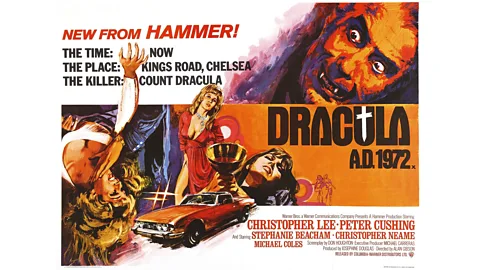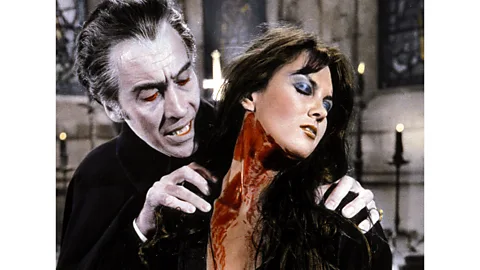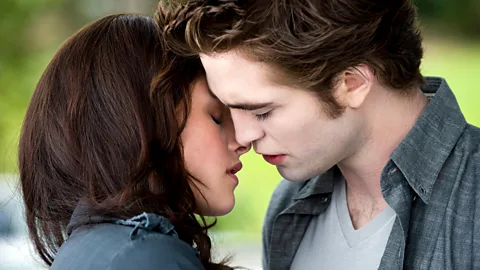The bizarre Dracula film that saw him meet the hippies
 Getty Images
Getty ImagesFifty years ago, Dracula AD 1972 saw the Count wreak havoc in swinging 1970s London – and was roundly derided by critics. But it changed the template for the iconic bloodsucker, writes David Barnett.
The tag-line of Dracula AD 1972 pretty much says it all: "The count is back, with an eye for London's hot pants… and a taste for everything!" Normally to be found haunting the shadowy castles and alleys of 19th-Century Europe, the iconic bloodsucker in this British horror cult classic instead wreaks havoc in London in the latter half of the 20th Century – the first time, really, that Dracula had been taken out of his Victorian milieu, and placed in a contemporary setting.
Released in cinemas 50 years ago, the movie came at the twilight of UK film company Hammer Productions' famed horror output, which began in 1955 with The Quatermass Experiment and had its heyday from the latter part of that decade until the late 1960s.
Much like its earlier US counterpart Universal Studios, Hammer assembled a stable of the classic horror monsters to bring to celluloid life – the mummy, Frankenstein's monster, werewolves –but with a British sensibility, and more gore and sex. For many cinemagoers, Christopher Lee's red-eyed Count Dracula became the archetypal big-screen incarnation, beginning with 1958's Dracula, a more-or-less straight adaptation of Bram Stoker's 1897 novel. By the time of Dracula AD 1972, however, Hammer had gone – in this case extremely – off-piste with their continuing chronicles of the Transylvanian villain.
 Alamy
AlamyWith the twin Hammer pillars of Lee and his regular sparring partner Peter Cushing, who played vampire hunter Abraham Van Helsing, headlining Dracula AD 1972, it seemed destined for success, even with Lee – in his penultimate outing as Dracula, his last being the loose follow-up The Satanic Rites of Dracula – reportedly being less than enthusiastic about the film. In his 2004 autobiography Lord of Misrule, Lee – while avowing a strong admiration for the character of the Count – wrote: "It was aesthetically depressing to see the films step by step deteriorate… with The Satanic Rites of Dracula I reached my irrevocable full stop."
The movie begins in typical Dracula-movie fashion, with a frantic chase as Cushing's vampire hunter Abraham Van Helsing pursues Lee's Transylvanian Count in 1872, eventually impaling him in novel fashion on a broken carriage wheel, dying himself in the process. One of popular culture's greatest hero-villain dynamics is finally over. But as one of Dracula's followers buries his ashen remains near Van Helsing's grave in London's St Bartolph's Church he glances to the sky… and suddenly a passenger jet flies overhead, segueing the story rather neatly to a hundred years' hence. And here, in 1972, we find a brooding Christopher Neame as Johnny Alucard (a cunning nom-de-plume that absolutely none of his friends thinks to say backwards), a hippie disciple of the undead count whose mission is to bring Dracula back in order to wreak havoc on Swinging London.
Not even Dynasty star Stephanie Beacham, playing both an acquaintance of Alucard and a descendant of Dracula's nemesis Van Helsing, twigs what's up with him – even when, following a prolonged party scene soundtracked by the 1970s blues-rock band Stoneground (apparently Rod Stewart and the Faces were at one point in the frame to be the live band on screen), Alucard takes her and their bored hippie crew off to St Bartolph's Church to perform a Satanic rite for a bit of a laugh. Which does, of course, bring Dracula back in rude health and – as the tag-line says – with an eye for hot-pants… not to wear them himself, of course, but to chomp into their owners.
"This isn't a terrific rationale for another horror flick but, given Miss Beacham's ability to heave, and her bosom to heave with, it will have to do," wrote the famed and feared film critic Roger Ebert on the movie's release in 1972. He also, somewhat curiously, praised it with faint damnation by bemoaning the fact that Hammer "now seems willing to follow the artistic leads of violence-come-latelies like Kubrick. Alas". Meanwhile, the Monthly Film Bulletin said it was "an abortive and totally unimaginative attempt to update the Bram Stoker legend to present-day Chelsea". These were typical of the reviews at the time, which followed on from the derisory notices also given to Hammer's previous Dracula movie, Scars of Dracula. It seemed that, certainly in reviewers' minds, Hammer's custodianship of Bram Stoker's creation had become anaemic by the time AD 1972 was released.
A case for the defence
"Hammer's Dracula films weren't generally well-reviewed anyway – and fans tended then to be stuffy about innovations," says Kim Newman, novelist, writer and film critic. "It was the first Hammer Dracula I saw in a cinema and I loved it – I saw it again on television later in the 1970s and thought it was hopelessly dated. I've since warmed up to it again … AD 1972 has its kitsch/camp elements, but the action scenes are terrific, the characters are vivid and engaging, and I like the score." What Dracula AD 1972 did also, in plucking the Count out of his period setting, and bringing him bang up to date, should not be underestimated.
 Alamy
AlamyAnother big fan of the film is the writer, actor and Sherlock co-creator Mark Gatiss, whose 2020 BBC TV miniseries about the Count with Sherlock collaborator Steven Moffat pulled a similar trick. It placed Dracula (played with menacing charm by Claes Bang) in his original context and then, midway through the story, turned everything on its head by having him surface in the modern day. Gatiss couldn't be more effusive about Dracula AD 1972, flaws and all. "It's such a joyful thing and I'm so glad it exists," he says. "I’ve always loved this film, principally because it's so wrong. It has a wonderful naffness to it, and I think that comes from the fact they originally planned to make it in 1969, but by the time they released it in 1972, the hippy thing was already so dated."
He adds that its seemingly maverick premise was true to the spirit of Bram Stoker's novel because that itself offered an updating of the vampire story from its traditional home in several-centuries-old legends. "People often forget how radical the original novel is," he says. "Dracula comes to England for new horizons, new blood, his land is old and dead, and what became the standard setting for Dracula adaptations, Victorian England, was new and contemporary at the time." Neverthless, like Newman too, Gatiss thinks the follow-up, The Satanic Rites of Dracula, which keeps Dracula in the modern era, this time going up against secret service agents, is a better film, "gritty and very creepy", and perhaps a more fitting send-off for Lee's career as the titular bloodsucker. "I don't think Christopher Lee was very happy with Dracula AD 1972 at all," Gatiss adds. "If you look at publicity photos from the film, he looks so miserable!"
However someone who was very happy with it indeed was cult actress Caroline Munro, who, as the film's first victim Laura Bellows, takes centre stage when she volunteers to be the focus of the ritual that brings Dracula back from the grave. Covered in blood that has been spilled all over her as she lies on the altar in the disused church, she is then confronted by the Count.
It was Munro's first Hammer film after studio boss Sir James Carreras spotted her on a billboard advertisement for Lamb's Navy rum. She would go on to forge a career in horror and sci-fi movies for both Hammer and others – starring in the likes of Captain Kronos, Vampire Hunter and At the Earth's Core, as well as then becoming a Bond Girl in 1975's The Spy Who Loved Me. "I'm not really sure how it was received by the critics or at the box office but I think a lot of young people related to it, and I also think it might possibly have been a little ahead of its time," she tells BBC Culture. "It was a very brave move by Hammer because it was so out there, and a lot of people thought, 'wow, what is this film?'"
Working with legends Lee and Cushing was awe-inspiring for Munro, who insisted that she didn't see Lee in his full Dracula get-up before her pivotal scene. She says, "The look on my face when he appears is real, because I wanted that surprise when his imposing figure looms up.
"I didn't have scenes with Peter Cushing but I got to know him better when we did At the Earth's Core," she continues. "Both he and Christopher were complete gentlemen, and I was so privileged to work with them. It was my first time working with such fantastic actors, Stephanie Beacham and Michael Kitchen as well. I was very, very nervous, but it was an amazing learning curve for me as an actress."
 Alamy
AlamyWhile the film might have been the first time that Dracula himself was updated to the contemporary era, the groundwork had already been laid, says Christopher Frayling, critic cultural commentator, and author of Vampire Cinema: The First 100 Years. He cites 1970's Count Yorga, Vampire, in which the titular vampire runs amok in present day Los Angeles, and Blacula, the "blaxploitation" favourite released just a couple of months ahead of the Hammer movie, as examples of preceding movies that brought a vampire into a contemporary setting.
Its key place in horror history
Nevertheless, even if it wasn't completely unprecedented, "Dracula AD 1972 is a fascinating film," Frayling tells BBC Culture "the start of Hammer's last hurrah, in a way. It is quite innovative, and an obvious attempt by Hammer to appeal to a younger audience, though the Swinging London teenagers did seem oddly old-fashioned by the time the film came out."
"The film is sort of a hyphen mark between Hammer's 1950s vintage and the new breed of horror movies that came after it," he continues. "The Exorcist was released in 1973, which propelled horror in a new direction, and in 1975 Stephen King's vampire novel Salem's Lot was published, which was made into a TV series. So Dracula AD 1972 was really the end of that particular era."
Newman – who would later use the Johnny Alucard name for one of the main characters in his Anno Dracula series of novels putting forward an alternate history where Count Dracula marries Queen Victoria – believes the film got a harsher reception than it should have done due to it being a later Hammer horror at a time when the company was struggling. " There wasn't resistance to the idea of a contemporary-set vampire movie," he says. "A few years later, Salem's Lot was basically Dracula reset in Peyton Place. Hammer were struggling to stay in the game, and some at the time saw only gimmicks – see also Dr Jekyll and Sister Hyde or The Legend of the 7 Golden Vampires for odd hybrids."
So though it was not quite sure what it wanted to be, and while it was perhaps not wholly successful in portraying the immortal Dracula at play in hip London town, Dracula AD 1972 has developed quite a following in the decades since. After its first DVD release in 2006, in particular, it found a new, appreciative audience. As the Classic Monsters website surmised, "the movie did what it was meant to, bringing a tired franchise up to date whilst retaining enough of its heritage to remain credible". And as the Grindhouse Database said, it is "an example of 1970s exploitation filmmaking at its most quirky and capricious … a delightfully entertaining experience”.
What would Bram Stoker have thought of it? We'll never know, of course, but his great grand-nephew Dacre Stoker, who has written many books on his ancestor's creation, thinks that, if nothing else, the film paves the way for Dracula to escape his Victorian bounds.
"It did provide an opening for authors and screenwriters to modernise Bram Stoker’s Victorian horror story, and unleash the Transylvanian count on a wide variety of audiences," he tells BBC Culture, adding jokily that "I would have thought that the music soundtrack was bad enough to kill the Count, but instead he was impaled by a spoke of a wooden carriage wheel, which I did think was quite clever."
Without the ambition of Dracula AD 1972 and its at-the-time daring and controversial move to bring Dracula into the modern era, the seed might not have been sown for other writers and film-makers to update the vampire legend themselves. Three years later, Stephen King published the aforementioned Salem's Lot, and the basic concept of the 1972 movie was repeated with turn-of-the-millennium Hollywood horror Dracula 2000, starring Gerard Butler as the Count, and its two sequels. Who knows, without AD 1972 we might never even have had modern-day vampire stories like Anne Rice's Interview With The Vampire, published in 1976, or the Twilight series, or Buffy the Vampire Slayer. It may be a faintly humorous curio in the horror canon, but it's an important one nonetheless.
Love film and TV? Join BBC Culture Film and TV Club on Facebook, a community for cinephiles all over the world.
If you would like to comment on this story or anything else you have seen on BBC Culture, head over to our Facebook page or message us on Twitter.
And if you liked this story, sign up for the weekly bbc.com features newsletter, called The Essential List. A handpicked selection of stories from BBC Future, Culture, Worklife and Travel, delivered to your inbox every Friday
